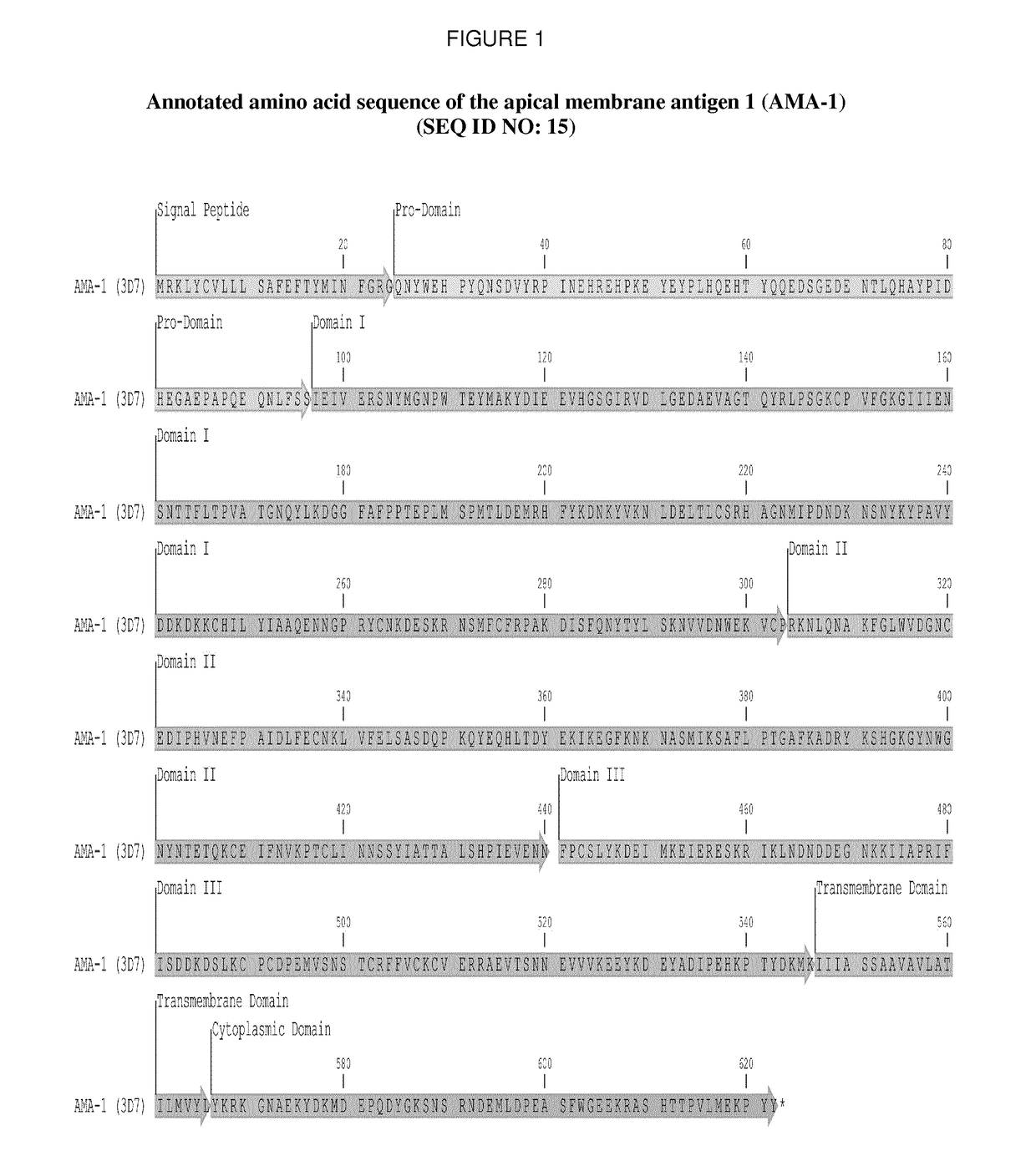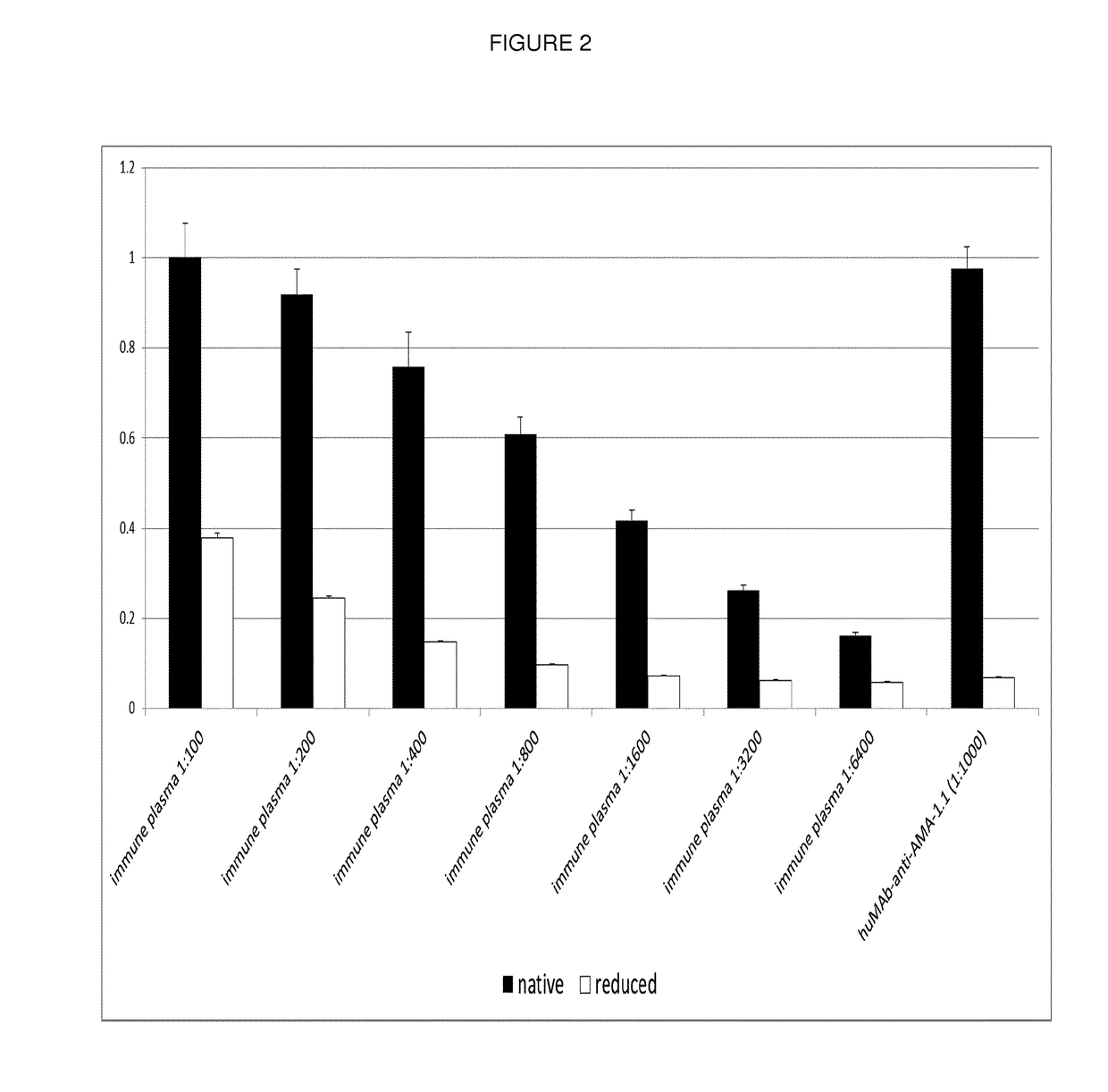Anti-plasmodium parasite antibodies
a technology of plasmodium parasites and antibodies, which is applied in the field of human antibodies against plasmodium parasites, can solve the problems of malaria being particularly serious, a major threat to public health, and many anti-malaria drugs are notorious for toxic side effects
- Summary
- Abstract
- Description
- Claims
- Application Information
AI Technical Summary
Benefits of technology
Problems solved by technology
Method used
Image
Examples
example 1
Memory B Cell Immortalization and V Gene Amplification
[0165]From one Ghanaian semi-immune adult, 50 ml of blood were withdrawn and PBMCs isolated by density gradient centrifugation. PBMCs were cryopreserved in FCS containing 10% DMSO and kept at −150° C. until usage.
[0166]Memory B cells were immortalized by Epstein Barr Virus (EBV) transformation according to standard procedures (Fraussen et al. 2010). Once B cell cultures were stably growing, cells were maintained in RPMI containing 10% FCS, 10 mM Hepes and 1 mM sodium pyruvate. Supernatants were collected and assayed for specificity against the antigen AMA-1. Corresponding EBV-transformed antibody-producing B cells were collected. Using the Cells-Direct Kit (Invitrogen), cDNA was directly prepared from 100-1000 cells. V genes were amplified from cDNA by nested PCR using primers described before (Tiller et al. 2008).
[0167]Amplified sequences were cloned into the plant expression vector pTRAkt expression vector system according to s...
example 2
Expression of Recombinant Antibodies in Nicotiana benthamiana
[0170]The recombinant expression of the antibodies was performed in Nicotiana benthamiana as described before (Boes et al. 2011). Basically, pTRAkt vectors containing either a light chain or a heavy chain antibody sequence were electroporated into Agrobacterium tumefaciens strain GV3101 (pMP90RK). Successful transformation was controlled by colony-PCR using the corresponding vector primers PS5 (ATCCTTCGCAAGACCCTTCCTCT) and PS3 (AGAGAGAGATAGATTTGTAGAGA). Positive clones were picked and grown in YEB medium containing kanamycin (25 μg / ml) and carbenicillin (50 μg / ml) in increasing medium volume, maintaining an approximate OD of 2-4. When a volume of 1 liter was reached, agrobacteria were diluted in infiltration medium (final concentration 2 g / l glucose, 50 g / l sucrose and 0,5 g / l Ferty Mega 2, pH5.6) containing 100 μM Acetosyringon to a final OD of 1 and incubated for 1 hour. For optimal expression, agrobacteria expressing t...
example 3
Determination of Antibody Specificity
[0172]Antibody specificity was estimated in a standard ELISA procedure. In short, the recombinantly produced AMA-1 from 3D7, produced in Pichia pastoris was coated overnight at 4° C. at a concentration of 1 μg / ml. Additionally, to control whether the antibody is binding a linear or conformational epitope, the antigen was reduced using 5 mM DTT (56° C., 45 min) and alkylated with 14 mM iodacetamide (RT, 30 min) and finally quenched using 5 mM DTT before coating. After a blocking step with PBS / 1% BSA for 1 h at RT, the primary antibodies or human plasma was added at indicated dilutions and incubated for 1 hour at RT. After 3 washing steps using PBS / 0.1% Tween20, the secondary goat anti-human IgG-alkaline phosphatase H+L specific, Promega (1:5000 in PBS) was added and also incubated for 1 h at RT. After a final washing step (3×1 minute in PBS / 1% Tween), the binding antibodies were visualized using pNPP (Sigma, N2765). Reactivities were quantified us...
PUM
| Property | Measurement | Unit |
|---|---|---|
| Fraction | aaaaa | aaaaa |
| Fraction | aaaaa | aaaaa |
| Fraction | aaaaa | aaaaa |
Abstract
Description
Claims
Application Information
 Login to View More
Login to View More - R&D
- Intellectual Property
- Life Sciences
- Materials
- Tech Scout
- Unparalleled Data Quality
- Higher Quality Content
- 60% Fewer Hallucinations
Browse by: Latest US Patents, China's latest patents, Technical Efficacy Thesaurus, Application Domain, Technology Topic, Popular Technical Reports.
© 2025 PatSnap. All rights reserved.Legal|Privacy policy|Modern Slavery Act Transparency Statement|Sitemap|About US| Contact US: help@patsnap.com



